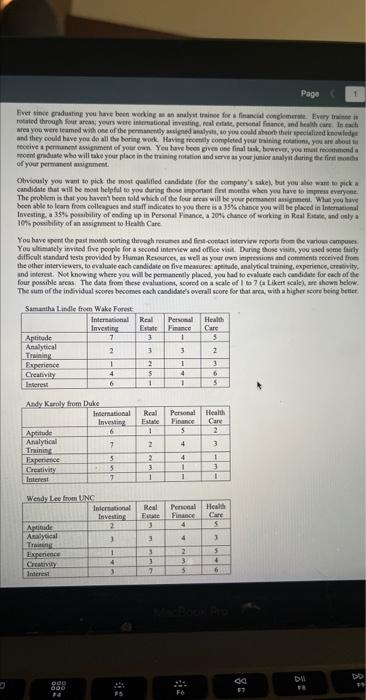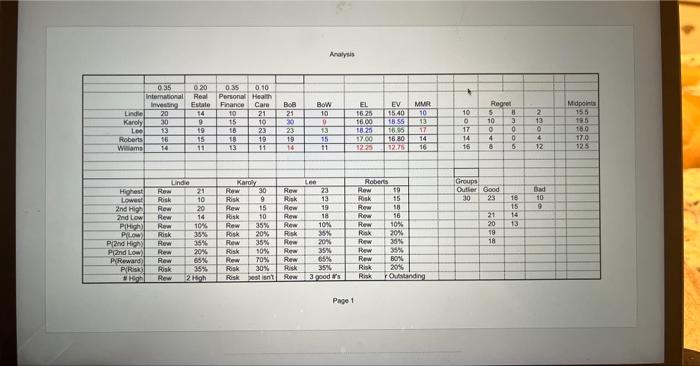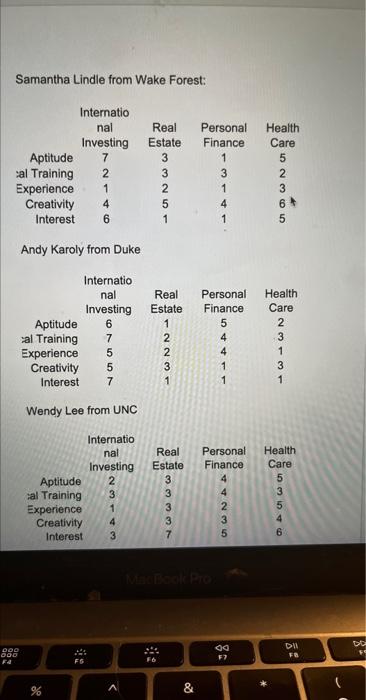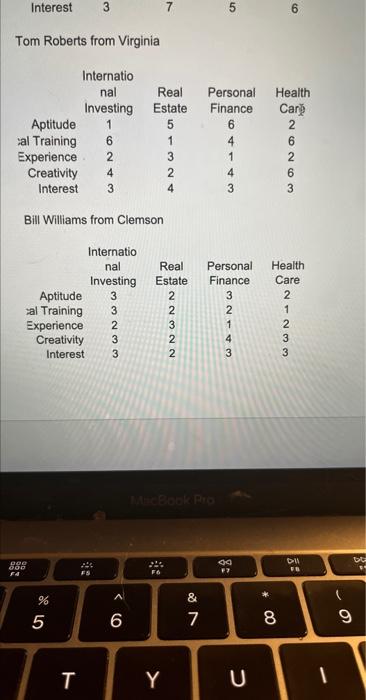Question
payoff table mini case Ever since graduating you have been working as an analyst trainee for a financial conglomerate. Every trainee is rotated through four
payoff table mini case
Ever since graduating you have been working as an analyst trainee for a financial conglomerate. Every trainee is rotated through four areas; yours were international investing, real estate, personal finance, and health care. In each area you were teamed with one of the permanently assigned analysts, so you could absorb their specialized knowledge and they could have you do all the boring work. Having recently completed your training rotations, you are about to receive a permanent assignment of your own. You have been given one final task, however, you must recommend a recent graduate who will take your place in the training rotation and serve as your junior analyst during the first months of your permanent assignment. Obviously you want to pick the most qualified candidate (for the companys sake), but you also want to pick a candidate that will be most helpful to you during those important first months when you have to impress everyone. The problem is that you haven't been told which of the four areas will be your permanent assignment. What you have been able to learn from colleagues and staff indicates to you there is a 35% chance you will be placed in International Investing, a 35% possibility of ending up in Personal Finance, a 20% chance of working in Real Estate, and only a 10% possibility of an assignment to Health Care. You have spent the past month sorting through resumes and first-contact interview reports from the various campuses. You ultimately invited five people for a second interview and office visit. During those visits, you used some fairly difficult standard tests provided by Human Resources, as well as your own impressions and comments received from the other interviewers, to evaluate each candidate on five measures: aptitude, analytical training, experience, creativity, and interest. Not knowing where you will be permanently placed, you had to evaluate each candidate for each of the four possible areas. The data from these evaluations, scored on a scale of 1 to 7 (a Likert scale), are shown below. The sum of the individual scores becomes each candidate's overall score for that area, with a higher score being better. 




Begin with a single sentence, saying simply I recommend we hire _______. You should not include the quotation marks and fill in the _______ with the name of the candidate you recommend. Start a new paragraph and explain to me why you chose the candidate you recommended. Focus entirely on the candidate you recommended, not the others. Be fair explain both the good points (rewards) and the bad (risks) and make me understand why the good points outweigh the bad. You probably wont have room to list all the risks and rewards of your preferred candidate, so make sure you include the most important ones. DO NOT (caps for emphasis) mention the decision rules at all. Talk only about the risks and rewards from the payoffs and probabilities. Essentially, you are giving me enough information so I could take your summary and using just the information in it, make a good argument to someone else about your recommended candidate. You must include the data in this paragraph Start another paragraph, and this time briefly compare your preferred candidate to the others. You will have even less room for this paragraph, so rather than doing a risk-to-risk or reward-to-reward comparison, talk about the candidates in an overall sense. You might include some of the data in this paragraph, but you might not. Again, you need to communicate a good level of understanding as to why you think your recommendation is better than the others. Do not show the payoff table at all. To write a one-page summary, start by writing a two+ page summary, including everything you want to say. Then go back and start editing and deleting until you get it down to one page.
Qf yout petwaticti ansigminte. You urimanely invitad five people for a sccotad intervicw and office visit. During bose vimin, you aed sime fairly the ether intervieweri, to evaluale each candidate on five measure: apt hade, analytical training, experience, crewitity. and isfercat. Not knowing where yora will be permanently placed, you had to cealuate each cascidate for cach of the four possible accas. The dasa from these evaluationt, scored oo a scale ef I to 7 f a Likert sealek ate ahowe belerw. The sum of the insividual woeres tecomes esch candidae's overall score for that area, with a higher serire beited better Yos shoeld ialk over the case analysis with your group, bui you take the in-elass (or prociored, for co-line aby fanis)h nest in Campia. It wail be wimilar to your daily quirees, with maltiple choice qacstions based on tie case data. Yos may use yoy hotes when taking the test. Sonce the lest at Not whout analysiz, the gucatices mill prinatily deal with the payoff table calcularions, deciason nies and iaformatioe from the lecnure notor about payoff tables and docision trect. It is firr, however, to ask quertions nuch an whethrr a particular valae wocld be considered a rick or rewant. Firally, you individually wrie a cne-page samnary where yoa make a reccmacndstion asd defirad is ( notking my recenting father than aning tlie deciaice rules. For that manter, you should not mention the decisico rules at all an Page 1 Samantha Lindle from Wake Forest: Andy Karoly from Duke Wendy Lee from UNC Tom Roberts from Virginia Bill Williams from ClemsonStep by Step Solution
There are 3 Steps involved in it
Step: 1

Get Instant Access to Expert-Tailored Solutions
See step-by-step solutions with expert insights and AI powered tools for academic success
Step: 2

Step: 3

Ace Your Homework with AI
Get the answers you need in no time with our AI-driven, step-by-step assistance
Get Started


